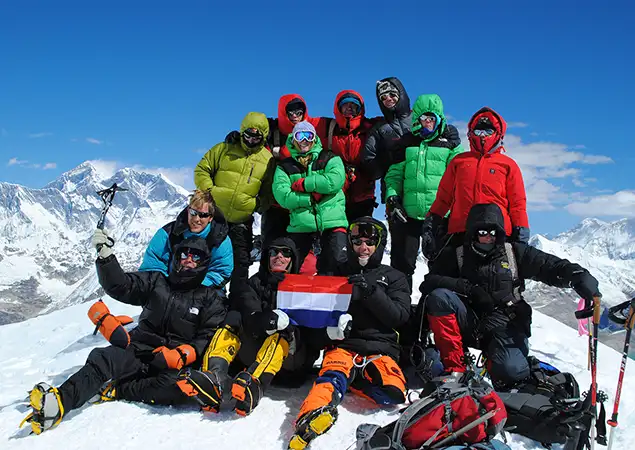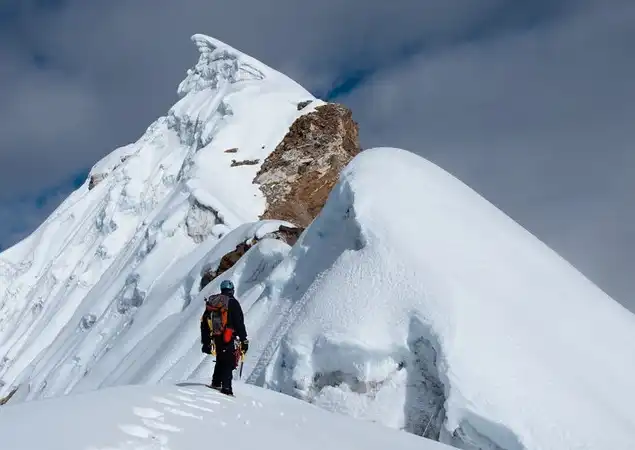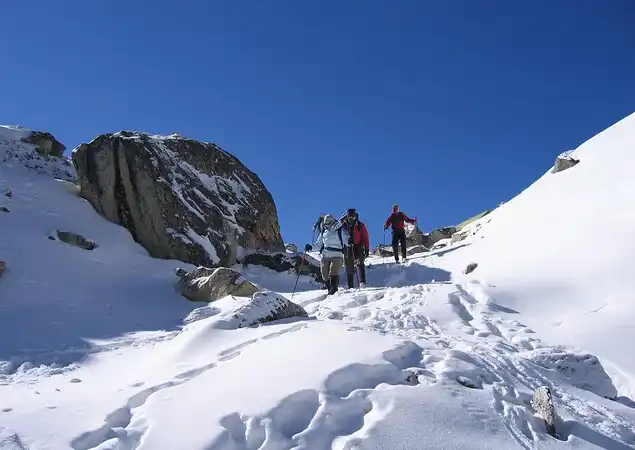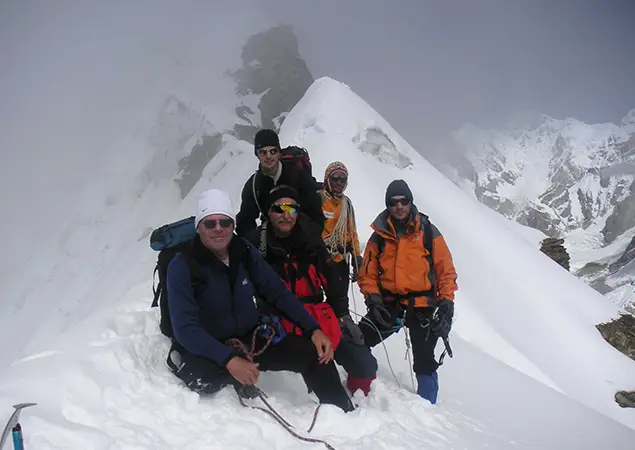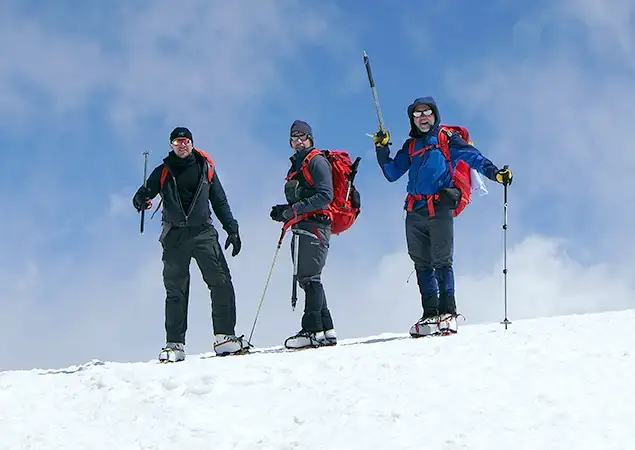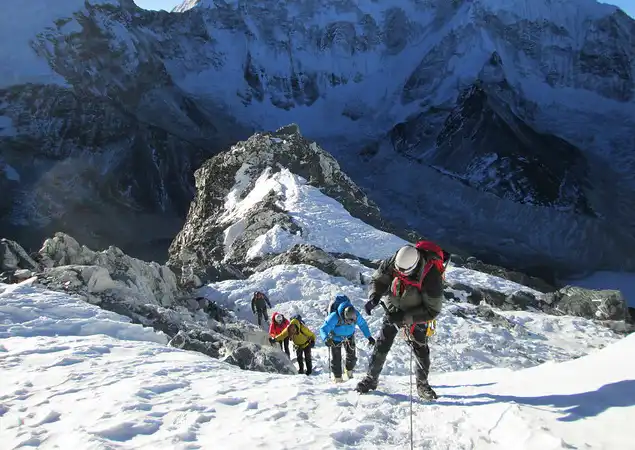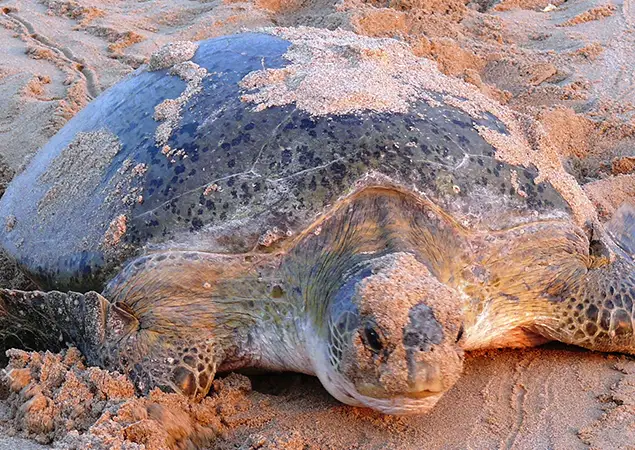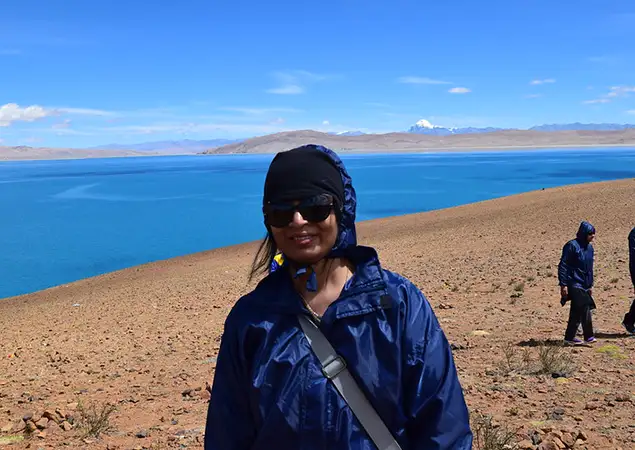Climbing Routes for Mera Peak
Choosing the correct climbing route is crucial for a successful Mera Peak Climbing Itinerary. Knowing the different routes to the summit can enhance your experience, regardless of your climbing expertise. Below is a detailed description of the standard route, alternative options for seasoned climbers, and key landmarks and waypoints to guide your ascent.
Standard Route to the Summit
The standard route to Mera Peak is the most popular path, favored for its relative safety and non-technical nature. This route approaches the summit from the north via the Mera La Pass and is suitable for climbers with basic mountaineering skills.
Key Features:
- Approach Through the Hinku Valley: The trek starts from Lukla and progresses through remote villages like Paiya, Pangom, and Nashing Dingma before entering the Hinku Valley.
- Gradual Elevation Gain: The itinerary includes acclimatization days at Thangnak (4,358 meters) and Khare (5,045 meters) to adjust to the high altitude.
- Glacier Traverse: From Mera Base Camp (5,350 meters), climbers traverse glaciers using crampons and ropes to reach Mera High Camp (5,780 meters).
Key Landmarks and Waypoints:
- Lukla, located at 2,860 meters, marks the starting point of the trek into the Everest region.
- Pangom La Pass (3,173 meters): Offers panoramic views of the surrounding peaks.
- Thangnak (4,358 meters): A crucial acclimatization stop with nearby trails for day hikes.
- Khare (5,045 meters): This is the last village before the ascent, offering a chance for final preparations before the climb.
- Mera Base Camp (5,350 meters): The summit serves as the staging area for the final push of the climb.
- Mera High Camp (5,780 meters): Offers shelter and rest before the final ascent.
- Summit of Mera Peak (6,476 meters): The highest trekking peak in Nepal, offering stunning views of Everest, Lhotse, and Makalu.
Alternative Routes for Experienced Climbers
For climbers seeking additional challenges, alternative routes provide more technical terrain and unique perspectives of the region.
Mera Peak via Amphu Lapcha Pass
- Description: This route extends the standard Mera Peak Climbing Itinerary by crossing the Amphu Lapcha Pass (5,845 meters) into the Everest region.
- Challenges: Involves technical climbing skills to navigate steep ice and rock sections.
- Benefits: Offers access to the remote Honku Valley and close-up views of Baruntse and Everest.
Mera Peak via Arun Valley
- Description: The route starts from Tumlingtar and passes through the less-traveled Arun Valley, merging with the standard route at Khote.
- Challenges: It’s a longer trek with substantial elevation changes and remote trails.
- Benefits: Provides cultural immersion with local Rai and Sherpa communities and explores untouched natural landscapes.
Key Landmarks and Waypoints for Alternative Routes
- Amphu Lapcha Pass (5,845 meters): This longer trek features significant elevation changes and remote trails.
- Seto Pokhari (4,810 meters): A sacred white lake encountered en route to Amphu Lapcha.
- Arun Valley: Known for its biodiversity and traditional villages.
Accommodation and Meals
Proper accommodation and meal planning are vital when undertaking the Mera Peak Climbing Itinerary. Knowing what to expect at various stops along the Mera Peak trekking route will enhance your comfort and overall experience. Below is detailed information on tea houses, lodges, and the facilities available during the trek.
Tea Houses and Lodges Along the Trek
Lower Elevations (Lukla to Khare):
Availability: In villages like Lukla, Paiya, Pangom, and Nashing Dingma, numerous tea houses and lodges are available.
Rooms:
- Basic twin-sharing rooms with beds and bedding.
- Shared bathroom facilities equipped with either squat or Western-style toilets.
Amenities:
- Electricity: Available for lighting and charging devices; may incur a small fee.
- Hot Showers: Offered in some lodges, usually at an additional cost.
- Wi-Fi and Communication: Limited internet access; intermittent mobile network coverage.
Higher Elevations (Khare to Mera High Camp):
Availability: As you ascend to places like Khare, Mera Base Camp, and High Camp, accommodation becomes increasingly essential.
Rooms/Tents:
- The lodges in Khare are simple, offering minimal facilities.
- Trekking companies provide tented camps at Mera Base Camp and High Camp.
Amenities:
- Sanitation: Basic toilet facilities, often eco-friendly pit toilets.
- Electricity: Generally unavailable; consider carrying a portable charger.
- Heating: Common areas may have a stove, but individual rooms are unheated.
Meals During the Trek
Tea House Meals:
Variety: Menus typically include Nepali, Tibetan, and essential Western dishes.
Common Options:
- Breakfast: Porridge, pancakes, eggs, and toast.
- Lunch/Dinner: Dal Bhat (rice with lentil soup and vegetables), fried rice, noodles, and momo (dumplings).
- Snacks: Common snacks include biscuits, chocolate bars, and dried fruits.
Beverages:
- Hot Drinks: Popular drink options include tea (black, ginger, lemon), coffee, and hot chocolate.
- Water: Boiled or purified water is available; it is advisable to use water purification tablets.
Meals at Higher Camps:
Preparation: Meals are cooked by the trekking crew’s cook staff.
Diet Focus: High-energy foods to meet the increased caloric needs at high altitudes.
Typical Menu:
- Soups: To aid hydration and warmth.
- Carbohydrates: Pasta, rice, and potatoes for energy.
- Proteins: Lentils, eggs, and occasionally meat (limited availability).
Facilities Climbers Can Expect at Different Stops
Lukla (2,860m):
- Accommodation: Well-equipped lodges with private rooms and en-suite bathrooms.
- Facilities: Hot showers, electricity, Wi-Fi, and various meal options.
Paiya to Khare (2,730m to 5,045m):
- Accommodation: Basic rooms with shared facilities; cleanliness varies.
- Facilities: Limited amenities; hot water and electricity may need to be more reliable.
Mera Base Camp (5,350m) and High Camp (5,780m):
- Accommodation: Tented camps with sleeping mats; no permanent structures.
- Facilities: Minimal; the focus is on essential needs for summit preparation.
- Meals: Simple and hearty, designed to provide necessary energy.
Climbing Difficulty and Altitude Information
Planning your Mera Peak Climbing Itinerary requires understanding the trek’s difficulty and altitude challenges. At 6,476 meters (21,247 feet), Mera Peak is the highest trekking peak in Nepal. Despite being considered non-technical, combining high altitude and rugged terrain demands thorough preparation and awareness.
Difficulty Level of the Trek and Climb
- Physical Fitness Requirements: Expect to trek 5 to 7 hours each day over diverse terrains, including steep climbs and descents. Muscular cardiovascular fitness and leg strength are best for effectively navigating the Mera Peak trekking route.
- Technical Skills: While Mera Peak is classified as non-technical, basic mountaineering skills enhance safety. Familiarity with crampons, ice axes, and ropes is advantageous. During acclimatization days in the Mera Peak Climbing Itinerary, guides often offer training sessions.
- Challenging Terrain: You will encounter glacier crossings and snowfields along the route. The final ascent involves climbing snow slopes with 30–35 degrees gradients.
- Weather Conditions: Adverse weather can elevate the difficulty level of Mera Peak. Temperatures may drop drastically near the summit, and strong winds are frequent, so appropriate gear and mental resilience are essential.
Tips on Managing Altitude Sickness and Acclimatization
Climbing to such high altitudes can cause Acute Mountain Sickness (AMS). Therefore, it is crucial to incorporate effective acclimatization strategies into your Mera Peak Climbing Itinerary.
Recognizing Symptoms of Altitude Sickness
- Mild Symptoms: Look out for headaches, nausea, dizziness, loss of appetite, and shortness of breath.
- Severe Symptoms: Be alert for persistent coughing, confusion, difficulty walking, and severe breathlessness even when resting.
Strategies for Proper Acclimatization
- Gradual Ascent: Ascend slowly, increasing your sleeping altitude by no more than 500 meters per day after reaching 3,000 meters.
- Include Acclimatization Days: Rest days are essential for acclimatization at high altitudes. Plan to rest at strategic locations like Thangnak and Khare to give your body time to adjust to the thinner air.
- Stay Hydrated: Consume at least 3 to 4 liters of water daily to facilitate acclimatization and alleviate AMS symptoms.
- Maintain a Balanced Diet: Eat high-calorie, carbohydrate-rich foods to supply the energy needed at high elevations.
- Avoid Alcohol and Smoking: Steer clear of alcohol and smoking, as they hinder acclimatization and can worsen altitude sickness.
- Climb High, Sleep Low: To acclimatize more effectively, consider hiking to higher altitudes during the day and descending to lower elevations for sleep. It allows your body to adjust to the reduced oxygen levels gradually.
- Medication: Discuss with your physician the use of Acetazolamide (Diamox) to prevent or mitigate AMS symptoms.
Monitoring Health During the Climb
- Regular Check-ins: Keep your guide informed about your condition; they are trained to spot AMS signs.
- Do Not Ignore Symptoms: Act if symptoms intensify; you may need to descend to a lower altitude promptly.
- Pace Yourself: Maintain a steady, manageable pace, as overexertion elevates the risk of altitude sickness.
Tips for a Successful Climb
Thorough preparation for your Mera Peak climbing itinerary enhances the chances of having a safe and enjoyable experience. Below are essential preparation tips, fitness requirements, and training suggestions to help you reach the summit confidently.
Preparation Tips and Fitness Requirements
- Physical Fitness: Build cardiovascular endurance through running, cycling, and swimming. Aim for at least three to six months of regular exercise before the trek.
- Strength Training: Include exercises that target your legs, core, and upper body for strength. Squats, lunges, and core workouts enhance stability and endurance on the Mera Peak trekking route.
- Altitude Training: Train at higher elevations to acclimate your body to lower oxygen levels. Alternatively, use altitude simulation masks during workouts.
- Hiking Experience: Gain experience with multi-day hikes carrying a backpack. Practice on varied terrains, including steep ascents and descents, to mimic the Mera Peak climbing route conditions.
- Technical Skills: Familiarize yourself with mountaineering equipment such as crampons, ice axes, and harnesses. It can be beneficial to take an introductory mountaineering course.
- Mental Preparation: Cultivate a positive mindset to handle the physical and psychological challenges. Techniques like meditation and visualization can improve focus and resilience.
Importance of Hiring Experienced Guides and Joining Organized Groups
- Safety Assurance: Experienced guides possess in-depth knowledge of the Mera Peak Climbing Itinerary and can safely navigate challenging sections.
- Altitude Management: Guides monitor climbers for signs of altitude sickness and implement proper acclimatization schedules.
- Logistical Support: Organized groups handle permits, accommodations, and meal arrangements, allowing you to concentrate on the climb.
- Cultural Insights: Local guides enhance your trekking experience by offering valuable insights into Sherpa culture and traditions.
- Camaraderie: Joining a group provides moral support and motivation, which can be crucial during difficult moments on the Mera Peak trekking route.
- Emergency Response: Guides are trained to respond to emergencies, including arranging evacuations if necessary.
Conclusion
The Mera Peak Climbing Itinerary presents an extraordinary opportunity to conquer one of Nepal’s highest trekking peaks. Highlights of the climb include panoramic views of the Himalayas, immersive cultural experiences, and the personal triumph of reaching the summit at 6,476 meters. Proper physical and mental preparation is vital in overcoming the Mera Peak difficulty level.
Planning ensures a successful and memorable climbing experience. By training adequately, hiring experienced guides, and following a well-structured Mera Peak Climbing Itinerary, you set the stage for the adventure of a lifetime. Embrace the challenge, respect the mountain, and look forward to the unparalleled rewards at the summit.
